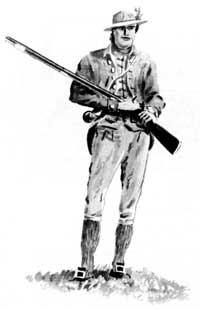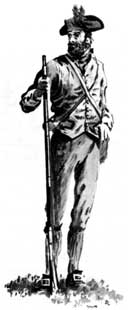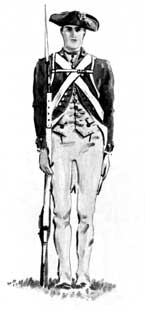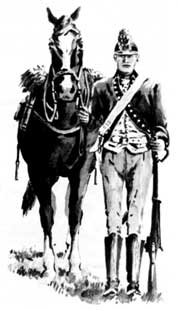|
GUILFORD COURTHOUSE National Military Park |
 |
British Lines
Lord Cornwallis commanded an army, numerically inferior to Greene's; but it was vastly superior in organization, discipline, training, and experience. Engaged in the Battle of Guilford Courthouse were about 2,000 of the very flower of the British forces in America. There were two battalions, a grenadier, and a light infantry company of the Guards; the 23d and 33d Regiments of foot, the former, the famous Welch Fusiliers; the 71st Highlanders, the King's Own Borderers; the Regiment of Bose, one of the best of the Hessian units; some Hessian Yagers (riflemen); Tarleton's Legion Cavalry; and a detachment of the Royal Artillery. All were veterans, thoroughly schooled in the business of war, and commanded by able, experienced officers.
Advancing toward the east from the scene of the opening skirmish along the New Garden Road, the attacking force crossed the stream at the foot of the hill in front of the American position, and formed for action. Meanwhile, the American artillery had opened fire in an attempt to delay the crossing, and to harass the formation of the line, but with little result. The British artillery replied with an equally useless expenditure of ammunition.
 North Carolina Militia in the First Line. |
 Virginia Militia in the Second Line. |
AMERICAN UNIFORMS
 Delaware and Maryland Infantry, Continental Line. |
 William Washington's Cavalry. |
Attack formation was a single line with a small reserve. The right wing consisted of the Highlanders and the Regiment of Bose with the 1st Battalion of Guards in support. In the left wing the 23d and 33d Regiments were in line and the 2d Battalion and Grenadiers of the Guards in support. The small reserve consisted of the artillery, confined by the woods to the road in the center; the Yagers and the Light Infantry of the Guards, stationed to the left in the woods; and the cavalry, on the road in column behind the artillery.

|
|
Last Modified: Mon, Dec 2 2002 10:00:00 am PDT |


